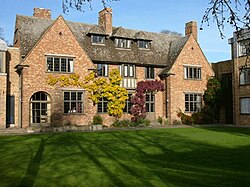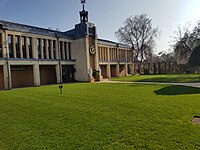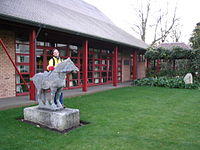Wolfson College, Cambridge
| Wolfson College
| |||||||||||||||||||
|
Ring True | |||||||||||||||||||
|---|---|---|---|---|---|---|---|---|---|---|---|---|---|---|---|---|---|---|---|
 Bredon House, Wolfson College | |||||||||||||||||||
 | |||||||||||||||||||
| President: | Jane Clarke | ||||||||||||||||||
| Website: | wolfson.cam.ac.uk | ||||||||||||||||||
| |||||||||||||||||||
| Location | |||||||||||||||||||
| Grid reference: | TL43595766 | ||||||||||||||||||
| Location: | 52°11’55"N, -0°5’58"E | ||||||||||||||||||
Wolfson College is a constituent college of the University of Cambridge, placed on the western outskirts of Cambridge, beyond Newnham village, in Cambridgeshire. The college was founded by the University itself in 1965 as "University College", but was refounded as Wolfson College in 1973 in recognition of the benefaction of the Wolfson Foundation. Wolfson is located to the south-west of Cambridge city centre, near the University Library.



The majority of students at the college are postgraduates. The college also admits "mature" undergraduates (aged 21 and above), with around 15% of students studying undergraduate degree courses at the university.
As one of the more modern colleges in Cambridge, Wolfson does not follow all of the traditions of some of the university's older colleges. For example, since the college's founding there has been no "High Table" reserved for Fellows at Formal Hall dinners; students and Fellows mix and dine together, and the tradition of wearing academic gowns to such occasions is encouraged but is not compulsory. Both Fellows and students at the college have access to all the facilities. With students from over 70 countries, Wolfson claims to be one of Cambridge's most cosmopolitan colleges.[1] It was the first college of the university to admit men and women as both students and FellowS.[2]
History
After the Second World War, the number of graduates of other universities who went to Cambridge to do research increased significantly. The university therefore decided to found University College in 1965 to help accommodate these students. The college was based at Bredon House, a property built in the early twentieth century by John Stanley Gardiner, who was a Professor of Zoology at the university from 1909 to 1937. He donated the house, with its long narrow garden running from Barton Road to Selwyn Gardens, to the university upon his death in 1946. The college then purchased further property on its eastern boundary.
University College was opened on 30 June 1965 as a college for postgraduate students, with the classicist John Sinclair Morrison as its first President. At the time, all the undergraduate colleges of the university were single-sex institutions and University College was the first in the university to admit men and women as both students and Fellows. The college, from its outset, set out to be a cosmopolitan and egalitarian institution with distinct differences from the older, more traditional Cambridge colleges, with no Senior Combination Room, no "High Table" reserved for Fellows at formal dinners in the college and no portraits hung in the Dining Hall.
The college's founding deed required the college to either find an endowment within 10 years or face dissolution. In 1972, the Wolfson Foundation agreed to provide a capital endowment and help to fund the construction of central buildings around Bredon House and the college's East and West Courts. In recognition of this, the college was renamed Wolfson College on 1 January 1973.
The new buildings (designed by the architect Michael Mennim) were opened by Queen Elizabeth II and the Duke of Edinburgh in 1977. Though most of the college's buildings are modern, the design of the campus is similar to that of the university's older colleges, with buildings grouped around two main courts. The floor of the entrance hall to the main building is made of thin slices of granite taken from the old London Bridge.
Further building and acquisition of neighbouring properties has continued. In the 1980s, the college purchased the house and garden owned by Sir Vivian Fuchs on the western side on the college. Plommer House on the northern side of the college was also left to the college in his will by Hugh Plommer, a founding Fellow of the college. The acquisition of property has allowed for the building of a number of new facilities, mainly funded by donations from philanthropic foundations and individuals. Other major benefactions have come from the Fairleigh Dickinson Foundation and the Toda Foundation. In the 1990s, with the help of the Gatsby Foundation, the college purchased the "western field" on which was built the Chancellor's Centre and further residential blocks.
Buildings and Grounds
The Lee Library
Opened in 1994, the Lee Seng Tee Library (Lee Library) was donated to the college by the Singaporean businessman and philanthropist Lee Seng Tee (whose daughter studied at the college). Lee also donated the funds used to build the Lee Seng Tee Hall. The library was designed by architects Brewer, Smith and Brewer. The ground floor foyer contains a scale model of the armillary sphere on the roof of the Peking Observatory. On the first floor is a bust of Lee Kong Chian, father of the benefactor. The library contains over 60 quiet places to work and is open 24 hours a day all year, apart from 25–26 December and 1 January.[3] The college is located a short walk from the University Library.[4]
In February 2018, students at the college were evacuated from the Lee library, and a number of accommodation blocks, after a wartime practice grenade was found in the President's Garden.[5]
College Gardens
In the first half of the twentieth century, much of the land on which the college is now situated comprised gardens which belonged to houses in Selwyn Gardens. As the college grew particular natural landmarks, such as the mulberry tree outside the Porters' lodge, were retained as features. The garden comprises a wide variety of trees, scented shrubs, dwarf conifers, as well as a distinctive range of shrubs with colourful stems.
The college's head gardener occasionally provides a guided tour of the gardens to local interested groups. During the summer, Wolfson opens its gardens to the public as part of the National Gardens Scheme Open Gardens network.[6]
Outside links
| ("Wikimedia Commons" has material about Wolfson College, Cambridge) |
References
- ↑ "Full-time Postgraduate study". Wolfson College, Cambridge. http://www.wolfson.cam.ac.uk/applying/graduate/masters/.
- ↑ "Archived copy". http://www.wolfson.cam.ac.uk/alumni/donations/annual-fund-brochure.pdf.
- ↑ "Welcome to the Wolfson College Library | Wolfson College Cambridge". University of Cambridge. https://www.wolfson.cam.ac.uk/library.
- ↑ "Library". University of Cambridge. http://www.wolfson.cam.ac.uk/tour/library.
- ↑ "Wolfson 'unexploded grenade' scare called off". Varsity Online. https://www.varsity.co.uk/news/14779.
- ↑ "Wolfson College Gardens | Wolfson College Cambridge". University of Cambridge. https://www.wolfson.cam.ac.uk/gardens.
| Colleges of the University of Cambridge | |
|---|---|
|
Christ’s • Churchill • Clare • Clare Hall • Corpus Christi • Darwin • Downing • Emmanuel • Fitzwilliam • Girton • Gonville and Caius • Homerton • Hughes Hall • Jesus • King’s • Lucy Cavendish • Magdalene • Murray Edwards • Newnham • Pembroke • Peterhouse • Queens’ • Robinson • St Catharine’s • St Edmund’s • St John’s • Selwyn • Sidney Sussex • Trinity • Trinity Hall • Wolfson |
 |
